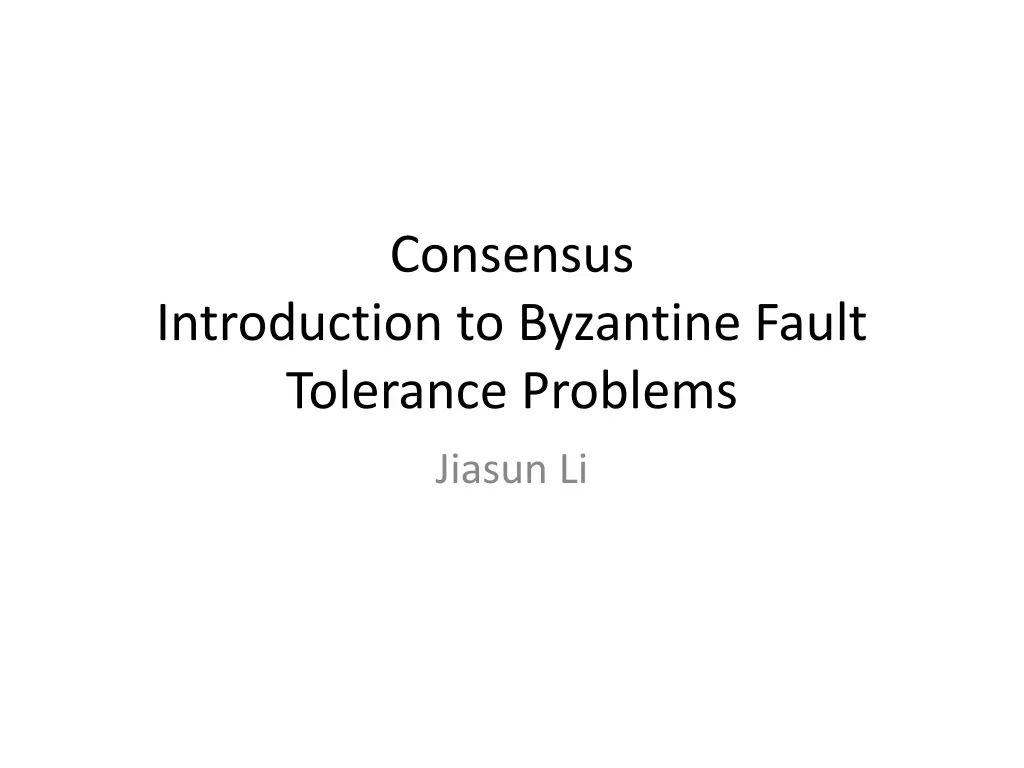
Introduction to Byzantine Fault Tolerance
Explore the concept of Byzantine Fault Tolerance, consensus algorithms, protocols, and related problems such as the Byzantine Generals Problem and the Two Generals Problem. Learn about higher-order belief/knowledge and the challenges of achieving agreement, validity, and termination in distributed systems. Delve into examples showcasing issues like delayed messages, synchrony, and strategic nodes.
Download Presentation

Please find below an Image/Link to download the presentation.
The content on the website is provided AS IS for your information and personal use only. It may not be sold, licensed, or shared on other websites without obtaining consent from the author. If you encounter any issues during the download, it is possible that the publisher has removed the file from their server.
You are allowed to download the files provided on this website for personal or commercial use, subject to the condition that they are used lawfully. All files are the property of their respective owners.
The content on the website is provided AS IS for your information and personal use only. It may not be sold, licensed, or shared on other websites without obtaining consent from the author.
E N D
Presentation Transcript
Consensus Introduction to Byzantine Fault Tolerance Problems Jiasun Li
Consensus algorithm (simplified) 1. New transactions are broadcast to all nodes 2. Each node collects new transactions into a block 3. In each round a random node gets to broadcast its block 4. Other nodes accept the block only if all transactions in it are valid (unspent, valid signatures) 5. Nodes express their acceptance of the block by including its hash in the next block they create
Consensus protocols Byzantine generals Problem Two generals problem Agreement/broadcasting problem; State-machine replication Nakamoto consensus pBFT: practical Byzantine Fault tolerance protocol HotStuff (Libra-BFT/Diem) Tendermint, etc. (Cosmos, Substrate, Polkadot)
The problem n nodes, among which f nodes are faulty The Agreement problem ? nodes; each has an input ??in a known set ?. A protocol s.t.: Agreement: no two honest nodes decide on different values. Validity: if all honest nodes have the same ? then ? is decided. Termination: all honest nodes eventually decide on a value in ?. The Broadcast Problem A leader node has some input ?. A protocol s.t.: Agreement: no two honest nodes decide on different values. Validity: if the leader is honest then ? is the decision value. Termination: all honest nodes eventually decide on a value in ?. State machine replication (SMR); safety and liveness
Examples Simple problems if common knowledge that All messages sent are received in a known fixed time Nodes always work properly (no crashing or lying) What if messages can be delayed? Synchrony, asynchrony, partial synchrony, etc. What if some nodes can be faulty? Threshold adversary: at most ? faulty nodes out of ? What if nodes are strategic?
Communication model Synchrony: There exists some known finite time bound s.t. any message sent can be delayed by at most Asynchrony: A message sent can be delayed by any finite amount of time i.e. a message must eventually be delivered but no bound exists on the delivery time Partial synchrony: There exists some known finite time bound and a special event called GST (Global Stabilization Time) such that: The GST event must happen after some unknown finite time Any message sent at time ? must be delivered by +max(t,GST) Source: Decentralized Thoughts by Ittai Abraham adapting DLS88 (somehow differs from DLS88 from my reading )
Fault Models Type of corruption Crash: stop sending and receiving messages Omission: drop or allow messages sent or received Byzantine: arbitrary actions (Typically) bounded computational power: Cannot forge signatures or invert hashes Full information vs. private channels Adaptivity: Static: adversary decides which ? nodes to corrupt before protocol execution. Adaptive: adversary decides dynamically as the protocol progresses who to corrupt based on what it learns over time. How long it takes between the adversary decision to corrupt and the event that the control is passed to the adversary? A standard assumption of instantaneous, other options see here. here
Some possibility/impossibility results ? < ? Byzantine Agreement possible under synchrony (Pease, Shostak, & Lamport, 1980) ? 3? Byzantine Agreement impossible under partial synchrony (Dwork, Lynch, & Stockmeyer, 1988) ? > 1, crash Agreement impossible under asynchrony (Fischer, Lynch, & Paterson, 1985)
Synchrony f<n: f+1 rounds of communication
? 3? Byzantine Agreement impossible under partial synchrony
? 3? Byzantine Agreement impossible under partial synchrony
? 3? Byzantine Agreement impossible under partial synchrony
Recent BFT development in Blockchain Tendermint (Buchman, 2016) BFT in the Age of Blockchains Casper (Buterin and Griffith 2017) Casper the Friendly Finality Gadget Hot-Stuff (AGM 2018) Hot-Stuff the Linear One-Message BFT Devil
BFT Consensus n=3f+1 authenticated communication channels agreement, eventual termination, validity partial synchrony eventually known bound safety maintained against asynchrony liveness during synchronous periods
Libra-BFT Adaption of HotStuff My understanding: marrying BFT and NC
Libra (Diem) A stablecoin solution Like MakerDAO, Tether, GUSD, USDC, etc. (so far) a permissioned system with 21 nodes Folded last year






















